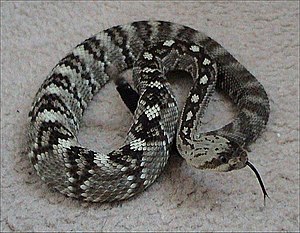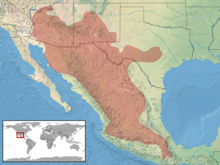Black-tailed rattlesnake
| Black-tailed rattlesnake | ||||||||||||
|---|---|---|---|---|---|---|---|---|---|---|---|---|

Black-tailed rattlesnake ( Crotalus molossus ) |
||||||||||||
| Systematics | ||||||||||||
|
||||||||||||
| Scientific name | ||||||||||||
| Crotalus molossus | ||||||||||||
| Baird & Girard , 1853 |
The black-tailed rattlesnake ( Crotalus molossus ) is a species of rattlesnake ( Crotalus ) found in Arizona , New Mexico , Texas, and much of central Mexico .
features
The black-tailed rattlesnake is a comparatively large rattlesnake with an average body length of about one meter.
The species varies a lot in its body color. Possible basic colors are gray, olive green, yellowish, rusty brown or cream-colored. The pattern consists of large dark brown or black spots on the back, which are usually outlined in light. It is named after the animals' characteristic black tail, and most of the individuals have a distinct black face mask that extends over the forehead and eyes and then forms a temple band to the corners of the mouth.
distribution and habitat
The range of the black-tailed rattlesnake includes central and southern Arizona , New Mexico and southwest Texas, and stretches south, where it occupies most of central Mexico. The coastal regions are not inhabited by this species.
As a habitat, the snake prefers mixed pine and oak forests and other areas rich in vegetation, very often in the transition area between the deserts and the forested mountain ranges.
Snake venom
The snake's venom usually leads to local tissue damage and pain, which is followed by general nausea . However, bites are relatively rare.
Systematics
The closest relative of the black-tailed rattlesnake is very likely the basilisk rattlesnake ( C. basiliscus ), which is parapatric with slight overlap with this species. Hybridizations occur in the contact areas of the two species .
There are currently four subspecies of the black-tailed rattlesnake:
- C. m. estebanensis on the island of San Esteban in the Gulf of California ; Typical of this subspecies is the tail rattle, which is very far back in shape
- C. m. molossus in the US-American part of the distribution area as well as in neighboring Mexico
- C. m. nigrescens in central Mexico and on the island of Tiburón in the Gulf of California
- C. m. oaxacus In the Mexican states of Oaxaca and Puebla ; it was temporarily added to the basilisk rattlesnake ( C. basiliscus ) as a subspecies
literature
- Chris Mattison: Rattlers! - A natural history of rattlesnakes. Blandford, London 1996; P. 114; ISBN 0-7137-2534-6
Web links
- Crotalus molossus in The Reptile Database
- Crotalus molossus inthe IUCN 2013 Red List of Threatened Species . Posted by: Hammerson, GA, Vazquez Díaz, J. & Quintero Díaz, GE, 2007. Retrieved October 5, 2013.

